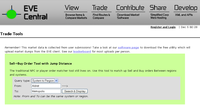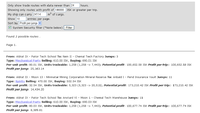More actions
No edit summary |
No edit summary |
||
| Line 1: | Line 1: | ||
== ***EVE-Central is no longer operational, most of this information can be applied to other tools like [https://evemarketer.com/ EVEMarketer], [https://eve-marketdata.com/ eve-marketdata], or [https://www.adam4eve.eu/ Adam4EVE]*** | =='''***EVE-Central is no longer operational, most of this information can be applied to other tools like [https://evemarketer.com/ EVEMarketer], [https://eve-marketdata.com/ eve-marketdata], or [https://www.adam4eve.eu/ Adam4EVE]***'''== | ||
One way to earn InterStellar Kredits (ISK) is to haul (move) goods from one location to another, buying low and selling high. | One way to earn InterStellar Kredits (ISK) is to haul (move) goods from one location to another, buying low and selling high. | ||
Revision as of 14:07, 23 May 2018
***EVE-Central is no longer operational, most of this information can be applied to other tools like EVEMarketer, eve-marketdata, or Adam4EVE***
One way to earn InterStellar Kredits (ISK) is to haul (move) goods from one location to another, buying low and selling high.
Establishing a Hauler Alt Character
Eve University students can make a good income as haulers, even during wartime, by setting up a hauler alt character outside of the corporation.

You can establish a hauler alt of any race, as described well in this guide: Creating an Alt Hauler. However, if you set up an alt character for hauling, consider making them Amarr, as they use a very attractive industrial ship, the Bestower, that requires a low level of skills, as follows:
- [[Skills:Amarr Industrial I]]
- Spaceship Command III
With this base level of skills, the Bestower will carry 4,800 m3 of cargo, without any modifications. Eventually, with maxed out skills, 4 Expanded Cargohold II mods, and 3 Cargo Optimization rigs, the Bestower will carry a whopping 24,114.9 m3. In short, with an Amarr hauler alt, you can get started quickly, and eventually end up with a very well equipped industrial ship.
Discover the Value of EVE-Central
The economic system in EVE is highly dynamic, driven in large part (but not all) by players, and the resulting supply and demand of goods. This results in disparities in buying and selling prices, resulting in the opportunity for trade routes, where haulers can buy at a low price in one location and then fulfill demand at a higher price in another.
The hauler's most valuable resource for finding profitable trade routes is the EVE-Central Market Aggregator website. EVE-Central aggregates market data from players all over New Eden giving you a (reasonably) up-to-date look at the markets all over the universe at a glance. The process outlined below will show you how to effectively use this website to your financial advantage. Using this tool, even a starting hauler with minimal skills and capital can routinely earn 300K ISK or more per trade run in high-sec space with virtually no risk. As your cargo capacity and available capital increase, trade runs worth millions of ISK in profit will become routine.
Using EVE-Central Effectively
Consider the following two points before you embark on your first hauling adventure:
- You will increase your likelihood of finding quick, zero-jump trade routes if you start in a high-sec system with lots of stations. This does not have to be in a trade hub like Jita, Hek or Rens. In fact, trade hubs tend to have higher turn-over rates in their markets, making the EVE-Central database frequently out of date for these systems. If you are starting an Amarr hauling alt, consider a system like Penirgman which has 19 stations and is close to the Amarr starting areas. Zero-jump trade routes won't necessarily be the most profitable per trip, but the trips are very short.
- Make sure your hauler alt always has enough capital to buy trade goods in sufficient quantity. For hauling consumer and industrial goods, you'll need about 10M ISK to start carrying near-full loads. If you don't have that amount on hand, don't worry - you can carry partial loads and you can earn the necessary capital over time. You'll always want to keep a buffer of ISK in your wallet that is sufficient to fill up your cargo hold if you can. Keep this in mind when you find yourself with enough money to add modules to your ship that increase its capacity, or upgrade your ship altogether. If you spend a significant portion of your ISK on the modules and/or new ship, you won't have enough left to be able to use the added volume. For those that are starting an Amarr hauling alt, your first upgrade to your Bestower will likely be four Expanded Cargohold IIs (~2M ISK) which will increase your cargo capacity to just over 13,000 cubic meters.
Selecting a trade route

- Open a web browser and open EVE-Central's Find Trade Routes and Compare website. We're going to be using the form within the upper green box entitled Sell->Buy Order Tool with Jump Distance.
- For pilots new to hauling and EVE-Central, select System to Region in the Query type: field, enter the name of your current system in the From: field, and your current region in the To: field. Your current system and region can be found in the upper left of the EVE user interface. When all of that is entered, click the Search & Display button. If you're curious about the different options in the Query type pulldown, here is a quick overview:
- The Regions option allows you to select two regions to find trade routes between. This will generally provide you with high jump count trade routes where the starting system may be quite a ways from where you are currently. This option will provide routes with the highest profits per trip, but these routes will generally require very large cargo capacities and starting capital. They are best suited to larger freighter operations and not beginner pilots.
- The Systems option allows you to select a specific starting system (generally the one you are in) and a specific ending system. This is best used when you need to move your character to another system for some other reason and just want to see if there is a profitable cargo load you could bring with you to make some cash on your way. In general, the Systems option is not optimal for maximizing profits so we will ignore it for now.
- The System to Region option allows you to provide the name of a system in the From: text box (usually the system you are currently in) and a region to select destinations from in the To: text box (usually the region you are currently in). The result will be a list of trade routes that start in your system, aren't egregiously long, and maximize profits. Until you advance to very large ships, this will be the option you use most frequently.
- You will be presented with a list of systems and regions that match your inputs (if you typed in the full name of the system and region correctly, the list will only have one entry). Select the system/region combination you want and then click the Display Routes button.

EVE-Central Trade Routes - You'll be presented with a list of all available trade routes from your current system to anything in your region. Before you go looking through the list, it's a good idea to enter your cargo capacity in the form at the top, select Profit per trip from the pulldown, and ensure that the System Security filter is checked (this will keep you out of lowsec). After changing any of the options in the form, click the Filter button to update the list of trade routes.
- Each entry in the filtered trade route list will contain several pieces of useful information.
- From: This is the station where the seller is located (it should be in your system).
- To: This is the station where the buyer is located (it should be in your region).
- Jumps: This is the number of jumps required to get from your system to the buyer's system.
- Type: This is the item type to be hauled.
- Selling: This is the per-unit price the seller is offering the item for.
- Buying: This is the per-unit price the buyer is offering for the item.
- Per-unit profit: This is how much profit you will make per item hauled (THIS DOES NOT INCLUDE THE 1.5% TAX!)
- Units tradeable: This is the number of units of the item that can be traded between the selected seller and buyer. The two numbers in parentheses are the number of items being offered for sale and the number of items that the buyer is looking to buy. The units tradeable quantity will be the smaller of these two numbers. Be careful, if the seller is offering more items than the buyer wants, you won't want to buy them all! Pay attention to this number.
- Potential profit: This is the profit that will be made if you buy all tradeable units (see above bullet) and sell them to the seller. Note that this may be more units than you can fit in your cargo hold, so realizing this profit may require multiple trips.
- Profit per trip: This is the amount of profit you should see if you buy enough items to fill your cargo hold (or all of the tradeable units, whichever is smaller). If this number is the same as the potential profit, then you have enough cargo hold space for all of the tradeable units and you should be able to realize full potential profits in one trip. Unfortunately, EVE-Central doesn't indicate how many units it will take to fill up your cargo hold if this number is less than units tradeable. You'll have to calculate that yourself based on the volume of one unit divided into the volume of your cargo hold.
- Profit per jump: This is just the profit per trip divided by the number of jumps (actually it is the number of gate jumps plus one, for reasons unknown). It is roughly an idea of profit per time spent executing the haul. In systems with lots of stations, you will likely discover some good trade runs with zero jumps! These may not have the highest profits, but they are very quick to execute. If you are in a hurry or just want to kill a short amount of time, then sort the list by Distance and knock off a quick zero-jump haul if available. If you want to maximize your profit, then sort by Profit per trip and work from there.
- There is no six.
- One important factor to consider before selecting your trade run is sales tax. The universal sales tax rate in EVE is two percent (2%), although this can be modified be skills training. EVE-Central does not include the effect of sales tax in its calculations, and this is a potential trap for haulers carrying low margin goods. While the vast majority of trade runs in EVE have more than a 2% margin between the buying and selling prices, it is never guaranteed. Smaller haulers are unlikely to haul low-margin items, since they naturally tend to focus on trading goods that maximize profit per cubic meter (m3) of their very limited cargo space. But freighters, and haulers with very large capacities, are more likely to select larger volumes of goods at lower margins, so they can fill their expansive holds, and they can get caught more easily in a sales tax trap.
- THIS STEP IS IMPORTANT: Most of the time, EVE-Central provides good trade run suggestions, but it's always a good idea to double-check. Verify that the EVE market window data is the same as the EVE-Central recommended route information. One way to do this is are websites that get up to date market information, like this market viewer. Select your Region in the top left and then search for the item you want to buy or sell. Remember though, that the market in a busy trade hub, such as Jita, can be so volatile that between uploading market data and doing the route search, it can change significantly. One way to avoid this problem is by doing your trading in relatively quiet systems with more market stability. If your trade rout ends in a trade hub it might be wise not to invest too much into a single run to avoid huge losses by inacurate market data.
Executing a trade run
- If your trade route checks out, make sure you are in the same station as the seller (they should at least be in the same system).
- Buy the items that you will haul. There may be multiple sell orders for that item in the station, make sure you get the right one! Note that there may also be some cheaper but at a lower volume than what EVE-Central listed—buy these first! Just make sure you end up with the same total item count in the end. The item will appear in your station hangar. Drag the item into your cargo hold. If it doesn't all fit, something has gone wrong with your math and you will need to make multiple trips.
- Warp to the seller's system and dock at their station.
- Open your cargohold and drag the items to be sold into your station hangar. Right-click the items to be sold in your station hangar panel and select SELL THIS ITEM. Check one last time that the buying price is the same as what you expected from the EVE-Central data - if it does, execute the sale. (If it doesn't, you may want to sell it anyway if it's still profitable. Use the Wallet/Transaction tab to find the price that you bought the item, if you forget. Be extremely leery about using the Advanced selling option to set your own selling price, as this will apply a broker fee, in addition to the usual sales tax, that can further erode or eliminate your profits.)
- Go back to the Selecting a trade route section and repeat for the next few trade runs.
What's the payoff?
Using this process, haulers can easily make 1 million ISK about every 20 minutes - sometimes a little more, sometimes a little less. Not a bad return for something that is almost risk free.
As warned above, EVE-Central does not include the effect of sales taxes or broker fees on your transactions. It's up to you to remember the potential effect that these costs will have on the profitability of your trades. Fortunately, the 1.5% standard sales tax is not hard to calculate.
You can reduce the amount of sales tax by training the Accounting skill - this reduces sales tax by ten percent per level. So, a fully maxed out Accounting V will cut the standard 1.5% sales tax by half, resulting in a sales tax rate of three-quarters of one percent (0.75%). However, the Accounting skill is relatively expensive to acquire (about 4.5 million ISK), so you will have to trade a great deal to earn that back from slightly lower sales taxes.
Broker fees will also apply if you use the Advanced option in your market trades to set a specific selling price, rather than selling at available market prices (i.e., selecting the "Sell This Item" option and accepting the offered market price). Broker fees are variable and can double your transaction costs, especially if your standing to the faction of the station where you are trading is poor. An illustration of the relationship of standings to broker fee can be found here: [1] In general, sell at market prices, and don't use the Advanced option when hauling - unless you really know what you are doing, and you believe that your higher potential profits will make the additional broker fee worthwhile.
You also have to watch out for suicide gankers, of course. To minimize this risk, don't autopilot, warp to 0 between gates, and jump manually. And: insure your ship - always.
Further Reading
- Hauling guide
- Syllabus of E-UNI class Hauling 101
- Recording of E-UNI hauling classes
- How not to die when hauling (2010)
- EVE Market Data, another handy EVE market database
